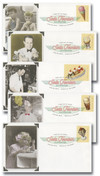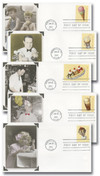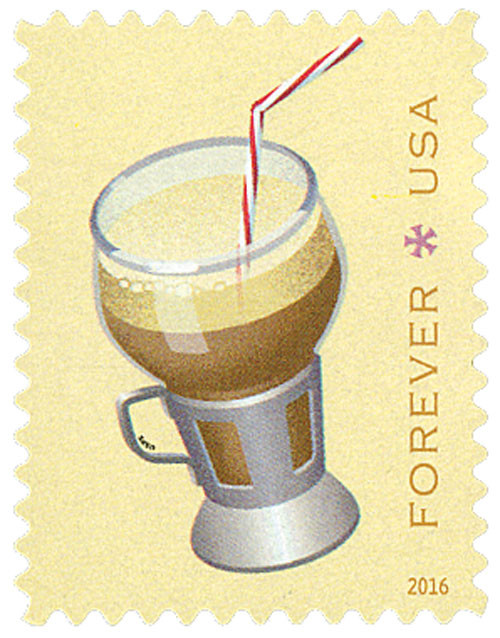
2016 First-Class Forever Stamp,Soda Fountain Favorites
# 5093-97 - 2016 First-Class Forever Stamp - Soda Fountain Favorites
$4.50 - $92.00
U.S. #5093-97
2016 47c Double Scoop Ice Cream Cone
The process for carbonating water was first developed in the early 1770s. The idea was to replicate the healing properties of mineral water and hot springs. People believed drinking carbonated water helped with illnesses or medical problems. And by the early 1800s, they could enjoy these healing beverages while socializing with friends at local drug store add-ons known as soda fountains.
By the 1850s, many soda beverages contained drugs such as cocaine or caffeine. At first, these were said to be completely safe for public consumption, but people soon became addicted to the drinks. In 1914, the U.S. government passed the Harrison Narcotics Tax Act, which regulated the use of certain drugs. This led to the sale of soft drinks instead.
From the late 19th to mid-20th century, soda fountains were the place to be. By the 1920s, nearly every drug store in America had one. And in the 1940s and 50s, their popularity skyrocketed. Many soda fountains expanded beyond soft drinks and offered treats like ice cream floats, sundaes, egg creams, and even small meals.
Though most of the drug store soda fountains are gone today, there are still those nostalgic few who keep the memory alive. And, if one is lucky, they might still find an old fashioned soda fountain in operation today.
By the 1850s, many soda beverages contained drugs such as cocaine or caffeine. At first, these were said to be completely safe for public consumption, but people soon became addicted to the drinks. In 1914, the U.S. government passed the Harrison Narcotics Tax Act, which regulated the use of certain drugs. This led to the sale of soft drinks instead.
From the late 19th to mid-20th century, soda fountains were the place to be. By the 1920s, nearly every drug store in America had one. And in the 1940s and 50s, their popularity skyrocketed. Many soda fountains expanded beyond soft drinks and offered treats like ice cream floats, sundaes, egg creams, and even small meals.
Though most of the drug store soda fountains are gone today, there are still those nostalgic few who keep the memory alive. And, if one is lucky, they might still find an old fashioned soda fountain in operation today.
Value: 47c
Issued: June 30, 2016
First Day City: Nashville TN
Type of Stamp: First Class Mail
Printed by: Banknote Corporation of America
Method: Offset, Microprint
Self-Adhesive
Quantity Printed: 50,000,000
U.S. #5093-97
2016 47c Double Scoop Ice Cream Cone
The process for carbonating water was first developed in the early 1770s. The idea was to replicate the healing properties of mineral water and hot springs. People believed drinking carbonated water helped with illnesses or medical problems. And by the early 1800s, they could enjoy these healing beverages while socializing with friends at local drug store add-ons known as soda fountains.
By the 1850s, many soda beverages contained drugs such as cocaine or caffeine. At first, these were said to be completely safe for public consumption, but people soon became addicted to the drinks. In 1914, the U.S. government passed the Harrison Narcotics Tax Act, which regulated the use of certain drugs. This led to the sale of soft drinks instead.
From the late 19th to mid-20th century, soda fountains were the place to be. By the 1920s, nearly every drug store in America had one. And in the 1940s and 50s, their popularity skyrocketed. Many soda fountains expanded beyond soft drinks and offered treats like ice cream floats, sundaes, egg creams, and even small meals.
Though most of the drug store soda fountains are gone today, there are still those nostalgic few who keep the memory alive. And, if one is lucky, they might still find an old fashioned soda fountain in operation today.
By the 1850s, many soda beverages contained drugs such as cocaine or caffeine. At first, these were said to be completely safe for public consumption, but people soon became addicted to the drinks. In 1914, the U.S. government passed the Harrison Narcotics Tax Act, which regulated the use of certain drugs. This led to the sale of soft drinks instead.
From the late 19th to mid-20th century, soda fountains were the place to be. By the 1920s, nearly every drug store in America had one. And in the 1940s and 50s, their popularity skyrocketed. Many soda fountains expanded beyond soft drinks and offered treats like ice cream floats, sundaes, egg creams, and even small meals.
Though most of the drug store soda fountains are gone today, there are still those nostalgic few who keep the memory alive. And, if one is lucky, they might still find an old fashioned soda fountain in operation today.
Value: 47c
Issued: June 30, 2016
First Day City: Nashville TN
Type of Stamp: First Class Mail
Printed by: Banknote Corporation of America
Method: Offset, Microprint
Self-Adhesive
Quantity Printed: 50,000,000














